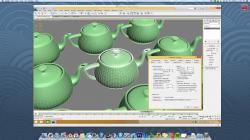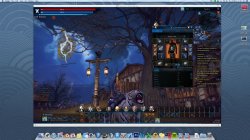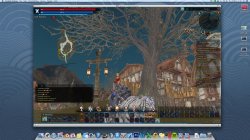So had to test this out.
My machine is a 2013 Mac Pro, 6 core / 16GB ram / D700
I have a Bootcamp partition on the main SSD with Windows 8.1 on it
Now switching between OSX and Windows is fine, takes around 1 to 2 minutes to switch but when you need a quick model export or a 3D rendering from a different angle, it became a pain to switch between the two operating systems. I work in Unity3D and Xcode for OSX/iOS development so need both OS's.
I installed Parallels Desktop 9 in Trial mode. Opted to use the existing BootCamp drive and got a warning that I might have to re-register certain software before continuing. Thats fine so I went ahead.
Windows 8.1 didn't ask to re-register so that was good although not tried booting back as a native OS on my mac yet.
Then I tried 3DSMax 2011 Design. This version doesn't use the later enhanced viewport displays. I left it on Direct3D and it popped up with a license error and to contact AutoDesk to resolve it. So I launched it again under OpenGL just to see if the same message would pop up and it didn't. Max loaded full screen while still in OSX, sweet!
For a test I created a biped, added a quick walk cycle and duplicated a teapot around the scene to make 92,000 Polygons, about the maximum I would use when creating game assets. I hit play and got 60 fps of viewport playback speed in smooth shaded. I switched from smooth shaded (F3) to mesh view (F4) and got 180 fps playback.
I rendered out a quick draft image of another project and it was spot on, took about 50% longer than native but the ease of which I can do this while still in OSX is great.
I also launched the game TERA thinking no way would this work, surprisingly it did, I did a quick Broker (Same as Auction House) check and managed a few sales then logged out. I could probably have played the game too but didn't test it for that long. No corruption, all worked spot on.
Will carry on using it as a proper development environment and see how things progress but so far will be buying the full version.
Cheers
Anim
My machine is a 2013 Mac Pro, 6 core / 16GB ram / D700
I have a Bootcamp partition on the main SSD with Windows 8.1 on it
Now switching between OSX and Windows is fine, takes around 1 to 2 minutes to switch but when you need a quick model export or a 3D rendering from a different angle, it became a pain to switch between the two operating systems. I work in Unity3D and Xcode for OSX/iOS development so need both OS's.
I installed Parallels Desktop 9 in Trial mode. Opted to use the existing BootCamp drive and got a warning that I might have to re-register certain software before continuing. Thats fine so I went ahead.
Windows 8.1 didn't ask to re-register so that was good although not tried booting back as a native OS on my mac yet.
Then I tried 3DSMax 2011 Design. This version doesn't use the later enhanced viewport displays. I left it on Direct3D and it popped up with a license error and to contact AutoDesk to resolve it. So I launched it again under OpenGL just to see if the same message would pop up and it didn't. Max loaded full screen while still in OSX, sweet!
For a test I created a biped, added a quick walk cycle and duplicated a teapot around the scene to make 92,000 Polygons, about the maximum I would use when creating game assets. I hit play and got 60 fps of viewport playback speed in smooth shaded. I switched from smooth shaded (F3) to mesh view (F4) and got 180 fps playback.
I rendered out a quick draft image of another project and it was spot on, took about 50% longer than native but the ease of which I can do this while still in OSX is great.
I also launched the game TERA thinking no way would this work, surprisingly it did, I did a quick Broker (Same as Auction House) check and managed a few sales then logged out. I could probably have played the game too but didn't test it for that long. No corruption, all worked spot on.
Will carry on using it as a proper development environment and see how things progress but so far will be buying the full version.
Cheers
Anim
Last edited:






